Understanding Camera Optics & Smartphone Camera Trends, A Presentation by Brian Klug
by Brian Klug on February 22, 2013 5:04 PM EST- Posted in
- Smartphones
- camera
- Android
- Mobile
Recently I was asked to give a presentation about smartphone imaging and optics at a small industry event, and given my background I was more than willing to comply. At the time, there was no particular product or announcement that I crafted this presentation for, but I thought it worth sharing beyond just the event itself, especially in the recent context of the HTC One. The high level idea of the presentation was to provide a high level primer for both a discussion about camera optics and general smartphone imaging trends and catalyze some discussion.
For readers here I think this is a great primer for what the state of things looks like if you’re not paying super close attention to smartphone cameras, and also the imaging chain at a high level on a mobile device.
Some figures are from of the incredibly useful (never leaves my side in book form or PDF form) Field Guide to Geometrical Optics by John Greivenkamp, a few other are my own or from OmniVision or Wikipedia. I've put the slides into a gallery and gone through them pretty much individually, but if you want the PDF version, you can find it here.
Smartphone Imaging
The first two slides are entirely just background about myself and the site. I did my undergrad at the University of Arizona and obtained an Optical Sciences and Engineering bachelors doing the Optoelectronics track. I worked at a few relevant places as an undergrad intern for a few years, and made some THz gradient index lenses at the end. I think it’s a reasonable expectation that everyone who is a reader is also already familiar with AnandTech.
Next up are some definitions of optical terms. I think any discussion about cameras is impossible to have without at least introducing the index of refraction, wavelength, and optical power. I’m sticking very high level here. Numerical index refers of course to how much the speed of light is slowed down in a medium compared to vacuum, this is important for understanding refraction. Wavelength is of course easiest to explain by mentioning color, and optical power refers to how quickly a system converges or diverges an incoming ray of light. I’m also playing fast and loose when talking about magnification here, but again in the camera context it’s easier to explain this way.
Other good terms are F-number, the so called F-word of optics. Most of the time in the context of cameras we’re talking about working F-number, and the simplest explanation here is that this refers to the light collection ability of an optical system. F-number is defined as the ratio of the focal length to the diameter of the entrance pupil. In addition the normal progression for people who think about cameras is in square root two steps (full stops) which changes the light collection by a factor of two. Finally we have optical format or image sensor format, which is generally in some notation 1/x“ in units of inches. This is the standard format for giving a sensor size, but it doesn’t have anything to do with the actual size of the image circle, and rather traces its roots back to the diameter of a vidicon glass tube. This should be thought of as being analogous to the size class of TV or monitor, and changes from manufacturer to manufacturer, but they’re of the same class and roughly the same size. Also 1/2” would be a bigger sensor than 1/7".
There are many different kinds of optical systems, and since I was originally asked just to talk about optics I wanted to underscore the broad variety of systems. Generally you can fit them into two different groups — those designed to be used with the eye, and those that aren’t. From there you get different categories based on application — projection, imaging, science, and so forth.
We’re talking about camera systems however, and thus objective systems. This is roughly an approximation of the human eye but instead of the retina the image is formed on a sensor of some kind. Cameras usually implement similar features to the eye as well – a focusing system, iris, then imaging plane.









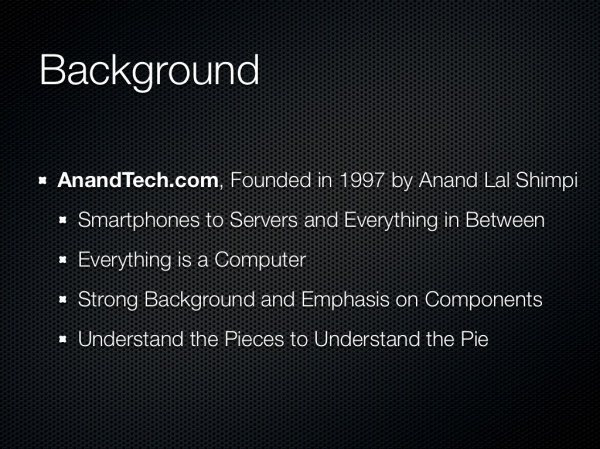
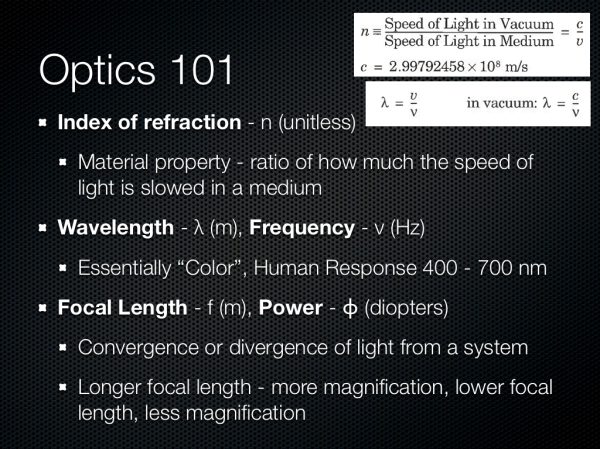
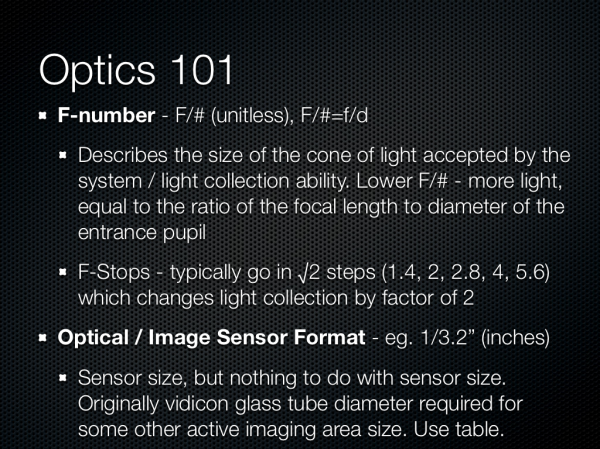
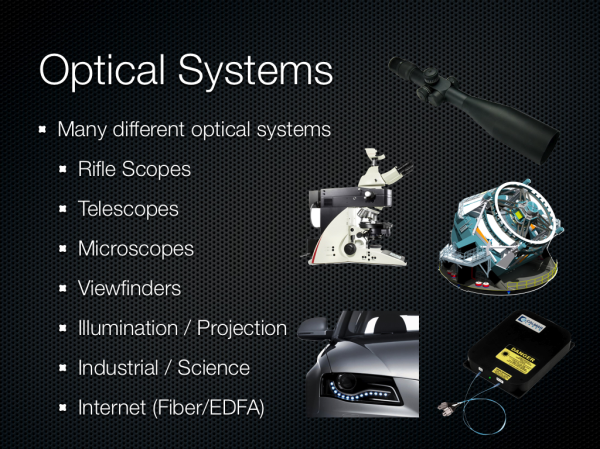
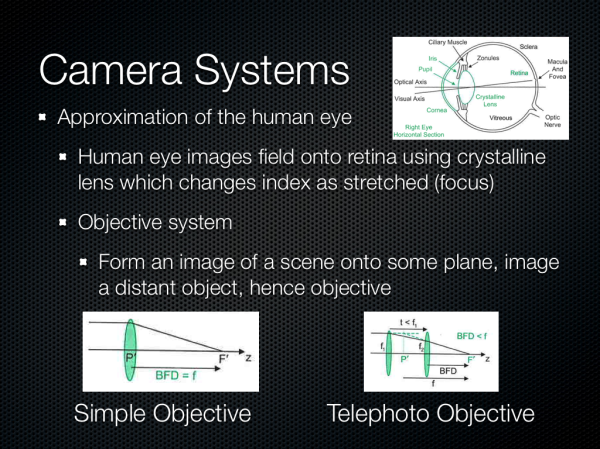








60 Comments
View All Comments
gadjade - Friday, February 22, 2013 - link
How can I start reading when there is no mention of any Nokia products? HTC One should not be even included in the article because it's not even considered a breakthrough in camera phones.Krysto - Saturday, February 23, 2013 - link
Next time try reading more than the first paragraph.Diagrafeas - Saturday, February 23, 2013 - link
How many MP or to be more accurate Million Sub Pixels are these Nokia sensors because these numbers come surely after interpolation or pixel shift or something...Also do we have information about HTC One sensor?
Is it one Bayer sensor or 2-3 stacked like Foveon ones?
Krysto - Saturday, February 23, 2013 - link
While HTC definitely deserves credit for discontinuing a trend of ever more MPs, I don't think they went far enough. There's still an unclenched status quo thinking in smartphones about sensor size. Virtually all of them have a 1/3.2" sensor.No one has even thought about making that one much larger? Even after Nokia showed Pureview 808 and got a lot of praise for it? Really? What is wrong with all these companies? Do they want us to spell it out for them?
I get that clean phone design is a big factor, but you can't just keep doing things the same way everyone has always done it. And then they wonder why they can't beat Samsung. Sure Samsung has a lot of marketing power, but they also play a little less safe than everyone else. They add the S-pen to devices, even though it adds quite a bit of cost and then they need that device to compete with others, so it's a risk for them that the consumers might not want to pay extra for it - but they still do it. They also started the "phablet" trend all by themselves. And while these things don't necessarily have mass market appeal, they get a lot of publicity and quite a lot of passionate fans and customers for those devices.
So why aren't the other manufacturers experimenting in the same way not just with incrementally better cameras, but WAY better cameras, that they put in phones. I'm talking putting camera capabilities in a phone that could add $100 or even $200 to the retail price of the device. That's being BOLD in the market. That's being DIFFERENT.
So I want to see them come up with devices that have 1" large sensors of 5-8 MP, with some high quality lenses, and powerful ISP's and software behind them. Create that and you get at least 3 different types of consumers coming to buy that phone (the type of consumers that yell :SHUT UP AND TAKE MY MONEY!): professional photographers (they buy thousands of dollars worth of equipment for fun, and they need phones, too), amateur photographers (people who love taking great photos with their phones), and you'd also pretty much convert the whole (in time of course) point and shoot market to your device.
So the potential for sales is right there for reaping. And these people wouldn't get about a slight bump on the back, if they can get a phone that is 5x better than anything else on the market at the time of shipping. I want to see that kind of LEAP in smartphone cameras, not just these regular "2013 camera is slightly better than the 2012 camera", and so on.
slatanek - Saturday, February 23, 2013 - link
I think you're generally right, but these days from manufacturer's point of view it's very easy to sink the ship by being bold and not being understood well by the market/consumers. It is then very easy for their opponents to do nasty counter marketing to make things worse even further.As a photographer myself I really would like to see a no compromise smartphone camera (give glass!!! give me bigger sensor with less megapixels!!!), but I guess we're not at that point just yet. Only recently manufacturers of compact cameras started to show some interest for making cameras geared toward serious photography, so I guess it's still a few years wait to see that approach in the smartphone world.
slatanek - Saturday, February 23, 2013 - link
Besides I guess 1" sensor in a smartphone will never happen due to physical constrains - you need a lot of light gathering power to lit such a huge sensor not to mention the focal distance needs to be considerably bigger for the field of view not to be ultra wideKrysto - Saturday, February 23, 2013 - link
Pureview 808 had a 1/1.2" which is pretty close, and didn't look too bad:http://images.fonearena.com/blog/wp-content/upload...
Tarwin - Saturday, February 23, 2013 - link
That's kinda the point. It didn't look TOO BAD, which is a far cry from looking great. I also remember reading some reviews which complained about the ergonomics. Also the pure view was more of a niche experimental product.It's kind of like some article that I read years agonwhere itnsaidnthat according to research (or a survey or something) consumers, when buying a tv), were most interested in size THEN image quality and then all the other stuff. Most phone buyers are similar, they want a better camera but are not willing to give up styling for it, at least not without some re-education.
As for HTC not going far enough. I think it has more to do with the fact that they're not doing too well as is and most likely feel like they're taking enough risks at the moment.
Personally I would be willing to give up some slimness (but hopefully not styling) for a decidedly improved camera. I hope HTC does well with the One and that they are willing to experiment a bit more in future generations. But then again I am not sure yet how I feel about the loss in detail. Another site got their hands on a One and have some comparison shots between the On eand the iPhone 5
Tarwin - Saturday, February 23, 2013 - link
Oops, accidentally pressed post.Well, in the comparison shots I prefernthe images ofnthe One, but I occasionally neednthe detail procided with 8MP but then again only sometimes. When 4K TVs vecome mainstream and I also have one then I'll kost likely think it's the minimum pics should be taken at.
Krysto - Monday, February 25, 2013 - link
They can make it more stylish than that. I wouldn't mind if my phone looked a bit like a point and shoot, and didn't have a perfectly flat back surface.Again, I'm not saying these phones are for everyone. Note phones are not for everyone either. In fact I don't think I can ever see myself owning a Note phone. But yet millions of people have them, and those who do love it, and wouldn't imagine going back to a smaller phone.
That's the type of market I think such a phone can target. A niche market indeed, but a big niche nonetheless. And I would be part of that niche.